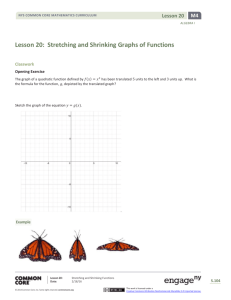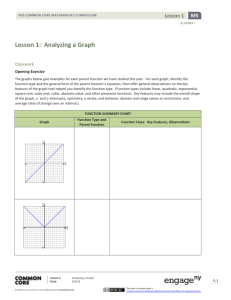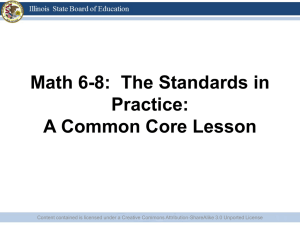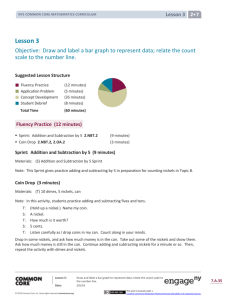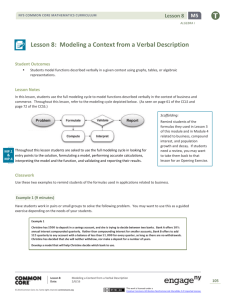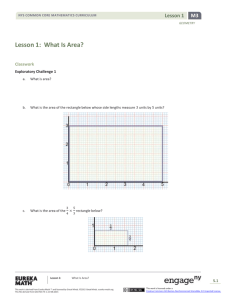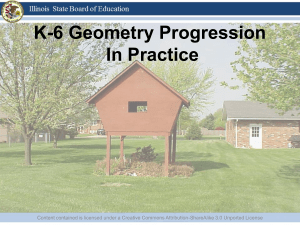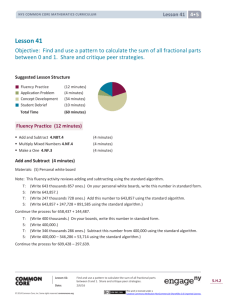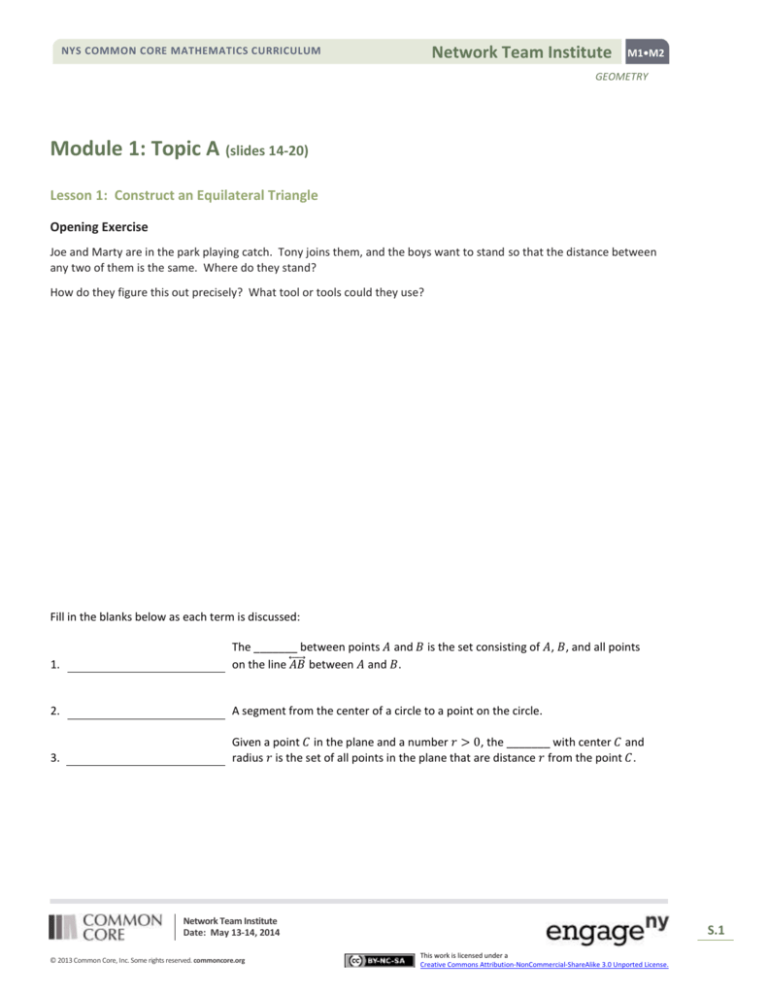
Network Team Institute
NYS COMMON CORE MATHEMATICS CURRICULUM
M1•M2
GEOMETRY
Module 1: Topic A (slides 14-20)
Lesson 1: Construct an Equilateral Triangle
Opening Exercise
Joe and Marty are in the park playing catch. Tony joins them, and the boys want to stand so that the distance between
any two of them is the same. Where do they stand?
How do they figure this out precisely? What tool or tools could they use?
Fill in the blanks below as each term is discussed:
1.
The _______ between points 𝐴 and 𝐵 is the set consisting of 𝐴, 𝐵, and all points
on the line ⃡𝐴𝐵 between 𝐴 and 𝐵.
2.
A segment from the center of a circle to a point on the circle.
3.
Given a point 𝐶 in the plane and a number 𝑟 > 0, the _______ with center 𝐶 and
radius 𝑟 is the set of all points in the plane that are distance 𝑟 from the point 𝐶.
Network Team Institute
Date: May 13-14, 2014
© 2013 Common Core, Inc. Some rights reserved. commoncore.org
S.1
This work is licensed under a
Creative Commons Attribution-NonCommercial-ShareAlike 3.0 Unported License.
Network Team Institute
NYS COMMON CORE MATHEMATICS CURRICULUM
M1•M2
GEOMETRY
Example 1: Sitting Cats
You will need a compass and a straightedge.
Margie has three cats. She has heard that cats in a room position themselves at equal distances from one another and
wants to test that theory. Margie notices that Simon, her tabby cat, is in the center of her bed (at S), while JoJo, her
Siamese, is lying on her desk chair (at J). If the theory is true, where will she find Mack, her calico cat? Use the scale
drawing of Margie’s room shown below, together with (only) a compass and straightedge. Place an M where Mack will
be if the theory is true.
Bookcase
Recliner
Rug
Table
J
Small rug
Desk
Bed
S
Chair
Network Team Institute
Date: May 13-14, 2014
© 2013 Common Core, Inc. Some rights reserved. commoncore.org
S.2
This work is licensed under a
Creative Commons Attribution-NonCommercial-ShareAlike 3.0 Unported License.
NYS COMMON CORE MATHEMATICS CURRICULUM
Network Team Institute
M1•M2
GEOMETRY
Example 2: Euclid, Proposition 1
Let’s see how Euclid approached this problem. Look at this venerable Greek’s very first proposition and compare his
steps with yours.
In this margin, compare your steps with Euclid’s.
Network Team Institute
Date: May 13-14, 2014
© 2013 Common Core, Inc. Some rights reserved. commoncore.org
S.3
This work is licensed under a
Creative Commons Attribution-NonCommercial-ShareAlike 3.0 Unported License.
NYS COMMON CORE MATHEMATICS CURRICULUM
Network Team Institute
M1•M2
GEOMETRY
Geometry Assumptions
In geometry, as in most fields, there are specific facts and definitions that we assume to be true. In any logical system, it
helps to identify these assumptions as early as possible, since the correctness of any proof we offer hinges upon the
truth of our assumptions. For example, in Proposition 1, when Euclid said, “Let 𝐴𝐵 be the given finite straight line,” he
assumed that, given any two distinct points there is exactly one line that contains them. Of course, that assumes we have
two points! Best if we assume there are points in the plane as well: Every plane contains at least three non-collinear
points.
Euclid continued on to show that the measures of each of the three sides of his triangle were equal. It makes sense to
discuss the measure of a segment in terms of distance. To every pair of points 𝐴 and 𝐵 there corresponds a real number
𝑑𝑖𝑠𝑡(𝐴, 𝐵) ≥ 0, called the distance from 𝐴 to 𝐵. Since the distance from 𝐴 to 𝐵 is equal to the distance from 𝐵 to 𝐴, we
can interchange 𝐴 and 𝐵: 𝑑𝑖𝑠𝑡(𝐴, 𝐵) = 𝑑𝑖𝑠𝑡(𝐵, 𝐴). Also, 𝐴 and 𝐵 coincide if and only if 𝑑𝑖𝑠𝑡(𝐴, 𝐵) = 0.
Using distance, we can also assume that every line has a coordinate system, which just means that we can think of any
line in the plane as a number line. Here’s how: given a line 𝐿, pick a point 𝐴 on 𝐿 to be “0” and find the two points 𝐵 and
𝐶 such that 𝑑𝑖𝑠𝑡(𝐴, 𝐵) = 𝑑𝑖𝑠𝑡(𝐴, 𝐶) = 1. Label one of these points to be 1 (say point 𝐵), which means the other point 𝐶
corresponds to -1. Every other point on the line then corresponds to a real number determined by the (positive or
negative) distance between 0 and the point. In particular, if after placing a coordinate system on a line, if a point 𝑅
corresponds to the number 𝑟, and a point 𝑆 corresponds to the number 𝑠, then the distance from 𝑅 to 𝑆 is 𝑑𝑖𝑠𝑡(𝑅, 𝑆) =
|𝑟 − 𝑠|.
History of Geometry: Examine the site http://geomhistory.com/home.html to see how geometry developed over time.
Relevant Vocabulary
Geometric Construction: A geometric construction is a set of instructions for drawing points, lines, circles and figures in
the plane.
The two most basic types of instructions are:
1.
Given any two points 𝐴 and 𝐵, a ruler can be used to draw the line 𝐴𝐵 or segment 𝐴𝐵.
2.
Given any two points 𝐶 and 𝐵, use a compass to draw the circle that has center at 𝐶 that passes through 𝐵
̅̅̅̅.)
(Abbreviation: Draw circle: center 𝐶, radius 𝐶𝐵
Constructions also include steps in which the points where lines or circles intersect are selected and labeled.
(Abbreviation: Mark the point of intersection of the lines 𝐴𝐵 and 𝑃𝑄 by 𝑋, etc.)
Figure: A (2-dimensional) figure is a set of points in a plane.
Usually the term figure refers to certain common shapes like triangle, square, rectangle, etc. But the definition is broad
enough to include any set of points, so a triangle with a line segment sticking out of it is also a figure.
Equilateral Triangle: An equilateral triangle is a triangle with all sides of equal length.
Collinear: Three or more points are collinear if there is a line containing all of the points; otherwise, the points are noncollinear.
Network Team Institute
Date: May 13-14, 2014
© 2013 Common Core, Inc. Some rights reserved. commoncore.org
S.4
This work is licensed under a
Creative Commons Attribution-NonCommercial-ShareAlike 3.0 Unported License.
Network Team Institute
NYS COMMON CORE MATHEMATICS CURRICULUM
M1•M2
GEOMETRY
Length of a Segment: The length of the segment 𝐴𝐵 is the distance from 𝐴 to 𝐵, and is denoted 𝐴𝐵. Thus, 𝐴𝐵 =
𝑑𝑖𝑠𝑡(𝐴, 𝐵).
In this course, you will have to write about distances between points and lengths of segments in many if not most
homework problems. Instead of writing 𝑑𝑖𝑠𝑡(𝐴, 𝐵) all of the time, which is rather long and clunky notation, we will
instead use the much simpler notation 𝐴𝐵 for both distance and length of segments.
Here are the standard notations for segments, lines, rays, distances, and lengths:
A ray with vertex 𝐴 that contains the point 𝐵:
𝐴𝐵 or “ray 𝐴𝐵”
A line that contains points 𝐴 and 𝐵:
⃡𝐴𝐵 or “line 𝐴𝐵”
A segment with endpoints 𝐴 and 𝐵:
𝐴𝐵 or “segment 𝐴𝐵”
The length of segment 𝐴𝐵:
𝐴𝐵
The distance from 𝐴 to 𝐵:
𝑑𝑖𝑠𝑡(𝐴, 𝐵)
Coordinate System on a Line: Given a line 𝑙, a coordinate system on 𝑙 is a correspondence between the points on the
line and the real numbers such that (i) to every point on 𝑙 there corresponds exactly one real number, (ii) to every real
number there corresponds exactly one point of 𝑙, and (iii) the distance between two distinct points on 𝑙 is equal to the
absolute value of the difference of the corresponding numbers.
Network Team Institute
Date: May 13-14, 2014
© 2013 Common Core, Inc. Some rights reserved. commoncore.org
S.5
This work is licensed under a
Creative Commons Attribution-NonCommercial-ShareAlike 3.0 Unported License.
NYS COMMON CORE MATHEMATICS CURRICULUM
Network Team Institute
M1•M2
GEOMETRY
Topic B: Unknown Angles (slides 21-24)
Lesson 8, Exercise 2:
Lesson 9, Discussion: What can be established about x, y, and z?
̅̅̅̅ ∥ ̅̅̅̅
̅̅̅̅ ∥ 𝐸𝐹
̅̅̅̅ . Prove that 𝑚∠𝐴𝐵𝐶 = 𝑚∠𝐷𝐸𝐹.
Lesson 10, Problem Set 1: 𝐴𝐵
𝐷𝐸 and 𝐵𝐶
Network Team Institute
Date: May 13-14, 2014
© 2013 Common Core, Inc. Some rights reserved. commoncore.org
S.6
This work is licensed under a
Creative Commons Attribution-NonCommercial-ShareAlike 3.0 Unported License.
Network Team Institute
NYS COMMON CORE MATHEMATICS CURRICULUM
M1•M2
GEOMETRY
Topic C: Transformations/Rigid Motions (slides 25-34)
Lesson 14, Exploratory Challenge:
△ 𝐴𝐵𝐶 is reflected across 𝐷𝐸 and maps onto △ 𝐴′𝐵′𝐶′.
Use your compass and straightedge to construct the
perpendicular bisector of each of the segments connecting 𝐴
to 𝐴′, 𝐵 to 𝐵′, and 𝐶 to 𝐶′. What do you notice about these
perpendicular bisectors?
Reflections and the Perpendicular Bisector:
Lesson 14, Example 1:
Construct the segment that represents the line of reflection
for quadrilateral 𝐴𝐵𝐶𝐷 and its image 𝐴′𝐵′𝐶′𝐷′.
What is true about each point on 𝐴𝐵𝐶𝐷 and its corresponding
point on 𝐴′𝐵′𝐶′𝐷′ with respect to the line of reflection?
Network Team Institute
Date: May 13-14, 2014
© 2013 Common Core, Inc. Some rights reserved. commoncore.org
S.7
This work is licensed under a
Creative Commons Attribution-NonCommercial-ShareAlike 3.0 Unported License.
NYS COMMON CORE MATHEMATICS CURRICULUM
Network Team Institute
M1•M2
GEOMETRY
Definition of Reflection:
For a line 𝒍 in the plane, a reflection across 𝒍 is the transformation 𝒓𝒍 of the plane defined as follows:
For any point 𝑷 on the line 𝒍, 𝒓𝒍 (𝑷) = 𝑷, and
2. For any point 𝑷 not on 𝒍, 𝒓𝒍 (𝑷) is the point 𝑸 so that 𝒍 is the perpendicular
bisector of the segment 𝑷𝑸.
1.
Lesson 14, Exit Ticket:
1. Construct the line of reflection for the figures.
2. Reflect the given figure across the line of reflection
provided.
Network Team Institute
Date: May 13-14, 2014
© 2013 Common Core, Inc. Some rights reserved. commoncore.org
S.8
This work is licensed under a
Creative Commons Attribution-NonCommercial-ShareAlike 3.0 Unported License.
NYS COMMON CORE MATHEMATICS CURRICULUM
Network Team Institute
M1•M2
GEOMETRY
Topic D: Congruence (slides 36-40)
Lesson 22, Discussion
Network Team Institute
Date: May 13-14, 2014
© 2013 Common Core, Inc. Some rights reserved. commoncore.org
S.9
This work is licensed under a
Creative Commons Attribution-NonCommercial-ShareAlike 3.0 Unported License.
NYS COMMON CORE MATHEMATICS CURRICULUM
Network Team Institute
M1•M2
GEOMETRY
Example from Mid-Module Assessment
̅̅̅̅
Given in the figure below, line 𝑙 is the perpendicular bisector of 𝐴𝐵
̅̅̅̅.
and of 𝐶𝐷
̅̅̅̅ ≅ 𝐵𝐷
̅̅̅̅ using rigid motions.
a. Show 𝐴𝐶
b. Show ∠𝐴𝐶𝐷 ≅ ∠𝐵𝐷𝐶.
c.
̅̅̅̅ ∥ 𝐶𝐷
̅̅̅̅.
Show 𝐴𝐵
Network Team Institute
Date: May 13-14, 2014
© 2013 Common Core, Inc. Some rights reserved. commoncore.org
S.10
This work is licensed under a
Creative Commons Attribution-NonCommercial-ShareAlike 3.0 Unported License.
NYS COMMON CORE MATHEMATICS CURRICULUM
Network Team Institute
M1•M2
GEOMETRY
Module 2 Topic A: Scale Drawings (slides 46-52)
For 𝑟 > 0, a dilation with center 𝑂 and scale factor 𝑟 is a transformation 𝐷𝑂,𝑟 of the
plane defined as follows:
1. For the center 𝑂, 𝐷𝑂,𝑟 (𝑂) = 𝑂, and
2. For any other point 𝑃, 𝐷𝑂,𝑟 (𝑃) is the point 𝑃 on
the ray 𝑂𝑃 so that |𝑂𝑃′| = 𝑟 ∙ |𝑂𝑃|.
Lesson 2, Example 2
Network Team Institute
Date: May 13-14, 2014
© 2013 Common Core, Inc. Some rights reserved. commoncore.org
S.11
This work is licensed under a
Creative Commons Attribution-NonCommercial-ShareAlike 3.0 Unported License.
NYS COMMON CORE MATHEMATICS CURRICULUM
Network Team Institute
M1•M2
GEOMETRY
Lesson 3, Example 2
Network Team Institute
Date: May 13-14, 2014
© 2013 Common Core, Inc. Some rights reserved. commoncore.org
S.12
This work is licensed under a
Creative Commons Attribution-NonCommercial-ShareAlike 3.0 Unported License.
NYS COMMON CORE MATHEMATICS CURRICULUM
Network Team Institute
M1•M2
GEOMETRY
Topic B: Dilations (slides 53-54)
Lesson 7, Example 3
Topic C: Similarity and Dilations (slides 55-64)
Lesson 12, Example 1
Z
Z'
Network Team Institute
Date: May 13-14, 2014
© 2013 Common Core, Inc. Some rights reserved. commoncore.org
S.13
This work is licensed under a
Creative Commons Attribution-NonCommercial-ShareAlike 3.0 Unported License.
NYS COMMON CORE MATHEMATICS CURRICULUM
Network Team Institute
M1•M2
GEOMETRY
Lesson 15, Discussion
Lesson 15, Exercise 9
x
3.14
4
12
y
16.5
Network Team Institute
Date: May 13-14, 2014
© 2013 Common Core, Inc. Some rights reserved. commoncore.org
S.14
This work is licensed under a
Creative Commons Attribution-NonCommercial-ShareAlike 3.0 Unported License.
Network Team Institute
NYS COMMON CORE MATHEMATICS CURRICULUM
M1•M2
GEOMETRY
Lesson 15, Problem Set 4
̅̅̅̅, ̅̅̅̅
̅̅̅̅, and ̅̅̅̅
̅̅̅̅, prove that the triangles are similar.
If ̅̅̅̅
𝑨𝑪||𝑬𝑫
𝑨𝑩||𝑬𝑭
𝑪𝑩||𝑫𝑭
Lesson 17, Discussion
Theorem (SAS). Given two triangles △ 𝐴𝐵𝐶 and △ 𝐴’𝐵’𝐶’ so that
𝐴′𝐵′
𝐴𝐵
=
𝐴′𝐶 ′
𝐴𝐶
and 𝑚∠𝐴 = 𝑚∠𝐴′ then the triangles are
similar, △ 𝐴𝐵𝐶 ~ △ 𝐴′ 𝐵′ 𝐶 ′.
Network Team Institute
Date: May 13-14, 2014
© 2013 Common Core, Inc. Some rights reserved. commoncore.org
S.15
This work is licensed under a
Creative Commons Attribution-NonCommercial-ShareAlike 3.0 Unported License.
Network Team Institute
NYS COMMON CORE MATHEMATICS CURRICULUM
M1•M2
GEOMETRY
Lesson 17, Discussion
Theorem (SSS). Given two triangles △ ABC and △ A’B’C’ so that
A′ B′
AB
=
B′ C′
BC
=
A′ C′
AC
then the triangles are similar, △
ABC ~ △ A′ B ′ C ′ .
Topic D: Applying Similarity to Right Triangles (slides 65-73)
Lesson 21, Example 1
How can we show that △ 𝐴𝐵𝐶~ △ 𝐵𝐷𝐶~ △ 𝐴𝐷𝐵?
Network Team Institute
Date: May 13-14, 2014
© 2013 Common Core, Inc. Some rights reserved. commoncore.org
S.16
This work is licensed under a
Creative Commons Attribution-NonCommercial-ShareAlike 3.0 Unported License.
NYS COMMON CORE MATHEMATICS CURRICULUM
Network Team Institute
M1•M2
GEOMETRY
Lesson 21, Example 2
Lesson 22, Discussion
How can the ratios in right triangles (e.g. shorter leg:hypotenuse) be used to prove the Pythagorean Theorem?
Network Team Institute
Date: May 13-14, 2014
© 2013 Common Core, Inc. Some rights reserved. commoncore.org
S.17
This work is licensed under a
Creative Commons Attribution-NonCommercial-ShareAlike 3.0 Unported License.
NYS COMMON CORE MATHEMATICS CURRICULUM
Network Team Institute
M1•M2
GEOMETRY
Which right triangle ratios can be used to express a in terms of other variables?
Topic E: Trigonometry (slides 74-81)
Lesson 27, Opening Exercise
B
β
a
c
What conclusions can be drawn based on each of the ratios?
α
A
b
Network Team Institute
Date: May 13-14, 2014
© 2013 Common Core, Inc. Some rights reserved. commoncore.org
C
S.18
This work is licensed under a
Creative Commons Attribution-NonCommercial-ShareAlike 3.0 Unported License.
Network Team Institute
NYS COMMON CORE MATHEMATICS CURRICULUM
M1•M2
GEOMETRY
Lesson 27, Example 2
Imagine that the hypotenuse has a fixed length of 𝑐 = 1 in △ 𝐴𝐵𝐶.
What happens to the value of the sine ratio and cosine ratio as 𝜃
approaches 0˚?
What happens to the value of the sine ratio and cosine ratio as 𝜃
approaches 90˚?
Lesson 27, Example 2
Network Team Institute
Date: May 13-14, 2014
© 2013 Common Core, Inc. Some rights reserved. commoncore.org
S.19
This work is licensed under a
Creative Commons Attribution-NonCommercial-ShareAlike 3.0 Unported License.
NYS COMMON CORE MATHEMATICS CURRICULUM
Network Team Institute
M1•M2
GEOMETRY
Lesson 28, Exercise 6
Lesson 29, Example 2
From an angle of depression of 40˚, John watches his friend approach his building while standing on the rooftop. The
rooftop is 16 meters from the ground, and John’s eye level is at about 1.8 meters from the rooftop. What is the
distance between John’s friend and the building?
Network Team Institute
Date: May 13-14, 2014
© 2013 Common Core, Inc. Some rights reserved. commoncore.org
S.20
This work is licensed under a
Creative Commons Attribution-NonCommercial-ShareAlike 3.0 Unported License.



